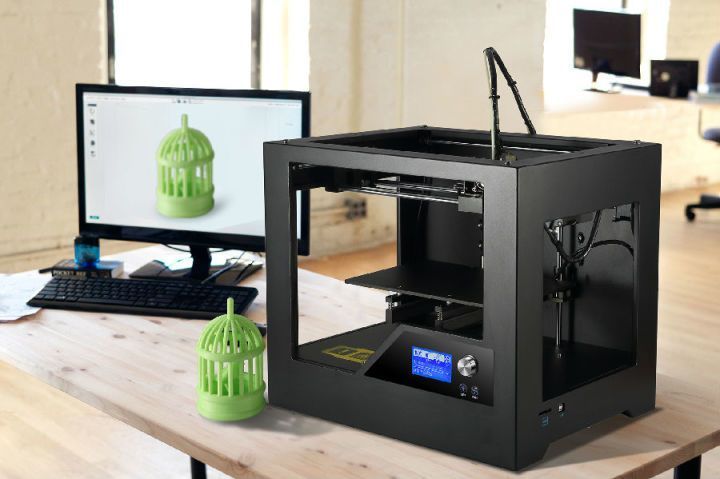What is the future of 3D printing? 2022 means that the first decade of the 3D printing industry has come to an end, and we are looking forward to the second decade.

Development trend:
1.Towards large-scale production
In the next decade, 3D printing will no longer be used only for customized products or high value-added products, but will cover the entire product life cycle from conceptual models to mass production and after-sales spare parts. In particular, the mass production of final parts will help 3D printing establish its position as a manufacturing technology in the next 10 years.
If 3D printing is obviously helpful in supporting and strengthening the supply chain at present, it will occupy an increasing share of the total manufacturing volume in the future and become the main large-scale manufacturing technology in the manufacturing industry. Whether in aerospace, industrial equipment, transportation, consumer electronics, medical and other fields, 3D printing will be more widely used, and various potential applications will become practical applications.
2.Iterative update of itself
3D printing research and development will be accelerated to better meet actual production needs. Among them, machines will become more versatile, enabling free-form manufacturing; while being able to print with minimal or no human involvement. The material portfolio will expand, with new 3D printing alloys, polymers and hybrid/metamaterials emerging.
3.Accelerate towards digitalization
In addition to advances in equipment and materials, 3D printing will rely on improved software to truly digitize production. At the same time, combined with artificial intelligence, machine learning will realize independent manufacturing, improve the process of the entire 3D printing work, and be smarter, and productivity will also be improved.
4.Capital will change the pattern
Looking forward to the next decade, the 3D printing industry will usher in a period of integration, and the pattern will definitely change completely. A large amount of capital is pouring into the industry, and there will be a series of mergers and acquisitions, which will trigger a wave of acquisitions, investments and IPOs. At the same time, some "traditional" manufacturing companies will "backdoor" enter the 3D printing field and play a role. There will be many cases similar to Nikon's acquisition of SLM Solutions.
In the next ten years, capital may also shift from betting on technology to focusing on applications rooted in real production scenarios.
5.Sustainable Distributed Manufacturing
3D printing will play a key role in reversing global warming through lightweighting, localization to reduce carbon footprint, lower energy consumption and waste reduction, and transition to plant-based materials, truly helping to achieve sustainability and a circular economy. In addition, 3D printing will be able to form a new supply chain solution through localized and distributed manufacturing. In the future, more industries will turn to digital warehousing and on-demand production of spare parts with the help of 3D printing.
Face the challenge:
The future of 3D printing is towards mass production, which requires solving three key issues: "price", "speed" and "quality".
Price
A big challenge is cost. The challenge is to reduce the cost per part across the value chain while maintaining the promise of quality. If the cost cannot be reduced, there will be no competitive advantage, and it will not be possible to truly move towards sustainable large-scale production.
3D printing materials are an important basis for the development of 3D printing technology, and the breakthrough of materials is the top priority. Not only the one-way cost control of materials, effective recycling is also crucial to reduce the cost of production-scale printing.
Speed
Mass production requires efficiency, that is, the need to overcome the limitation of 3D printing speed. This may be the biggest dilemma that major manufacturers have to solve. Not only need to solve the operating speed of the equipment itself, but also need to think about how to realize automation and reliable production. It can also be understood that production requires process automation.
Here it is necessary to effectively connect the 3D printing hardware and software, control the different stages of 3D printing intelligently through the software, start the operation and monitor the printing through artificial intelligence, and then the automatic filtration and cleaning system to obtain the final part. Digitizing and automating the production process of 3D printing is an effective way to solve the current slow speed.
Quality
If you want 3D printed parts to meet the quality of mass production, there is still a lack of standardization of the production process. This is mainly because, unlike most traditional manufacturing technologies, 3D printing has many process variables, and there is a highly coupled relationship between process, material and geometry; traditional process development and optimization paradigms can no longer adapt to the highly complex process characteristics of 3D printing. This has also led to a series of challenges that the 3D printing industry is still facing: time-consuming process development and optimization, difficult printing process control, low quality consistency, and unpredictable performance.
The solution that can be referred to is on the one hand to develop a semantics, providing common algorithmic tools that allow us to take semantic inputs and define production processes, parameters and designs. Another is the use of artificial intelligence (AI) software, which collects key process data from equipment and uses AI to analyze that data.
In mass production, the quality and reliability of production are key. How to improve printing speed and reduce production cost while balancing printing quality and ensuring success rate is a problem that industry participants need to work together to solve. In order to achieve this goal, we still need to make several times of efforts in the next 10 years to realize the C-position dream of 3D printing in the manufacturing industry as soon as possible.




 2023-02-08
2023-02-08 280
280 Well technology
Well technology






 Dylan xiao
Dylan xiao
